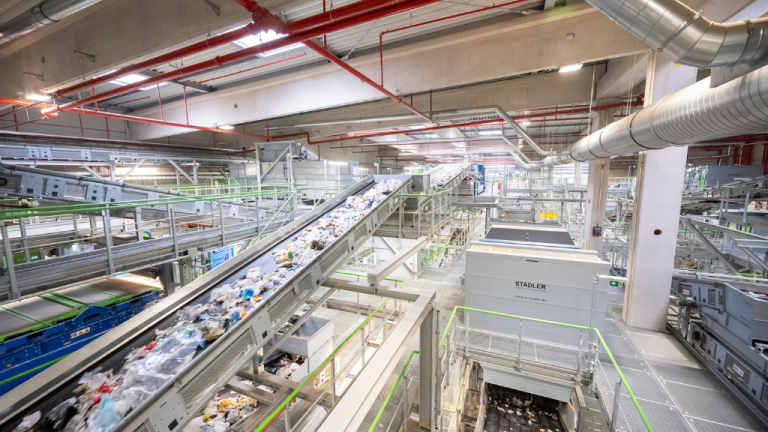Fourteen volumetric flow sensors developed in-house by STADLER continuously monitor material throughput, enabling real-time adjustments to maintain a stable, balanced feed to each sorting line.
STADLER
At the core of the Sollenau facility is a highly integrated and automated sorting system capable of processing lightweight household packaging as well as plastic bottles and lightweight packaging waste from commercial streams. The process begins with fully automated extraction of the input material from deep bunkers using an overhead gantry crane. After a size reduction stage, the material is sorted into different grain sizes.
A total of 35 Near-infrared (NIR) sorters from STEINERT are used throughout the process. Film materials are separated from the bulk stream using NIR sorters with air separation, then pass through four redundant sorting stages with further NIR sorters. Ferrous and non-ferrous metals, as well as beverage cartons, are removed during dedicated sorting stages, while the 3D material stream is sorted into several final product fractions across multiple NIR sorting stages.
Each sorting line features recovery NIR units from STEINERT that recirculate misclassified materials back to the beginning of the process, thereby closing the loop and ensuring exceptionally high sorting accuracy and optimal material recovery rates.
The system also incorporates the advanced AI-based BatterySort system, which enables early detection and safe removal of hazardous batteries. This is a vital innovation for fire prevention and improved material recovery, which PreZero highlighted as a standout feature of the plant.
To ensure smooth operation, the plant features intermediate buffering systems, redundant sorting lines, and fully automated baler control for the final output of up to 20 material fractions. It was designed to operate continuously, a key requirement for PreZero’s high-throughput operation: “One of our priorities in this project was to design a system architecture that ensures maximum availability and operational flexibility,” said Julius Henn, project manager at STADLER. “By integrating redundant sorting lines, intermediate buffering, and fully automated systems, we created a facility that can operate continuously, even during maintenance.”
“This built-in redundancy ensures continuous plant availability, minimizes downtime, and maintains high throughput even during technical servicing. It makes a real difference by increasing operational efficiency and reliability,” added Tristan Merk, project manager at PreZero.
A benchmark for the future of waste management
What makes the Sollenau plant so beneficial is the high level of intelligent automation throughout the entire process. Fourteen volumetric flow sensors developed in-house by STADLER continuously monitor material throughput, enabling real-time adjustments to maintain a stable, balanced feed to each sorting line.
Julia Stadler, Co-CEO of STADLER, explained: “Volume flow sensors ensure a consistent and balanced material flow throughout the entire plant. For instance, our patented screen-cut-control solution enables precise distribution across multiple sorting lines, forming the basis for automated operation and long-term process stability.”
The plant operates as a fully automated system that dynamically adapts to changing material compositions. This allows for optimal use of capacity while maintaining consistently high sorting quality. By minimizing manual intervention, the system increases efficiency, reduces downtime, and enables 24/7 operation.
Supporting Austria’s long-term sustainability goals
The plant is expected to make a significant contribution to regional recycling rates by improving sorting precision and material recovery: “PreZero tasked STADLER with delivering a highly automated, safe, and efficient sorting system tailored to complex recycling needs,” concluded Merk. “STADLER exceeded these expectations by designing and implementing a cutting-edge facility that integrates AI-based safety and meets the highest standards in sustainability and performance.”
As environmental regulations tighten and the demand for resource efficiency grows, the Sollenau plant stands as a model of what future-oriented recycling can achieve: scalable, intelligent, safe, and above all, sustainable.
